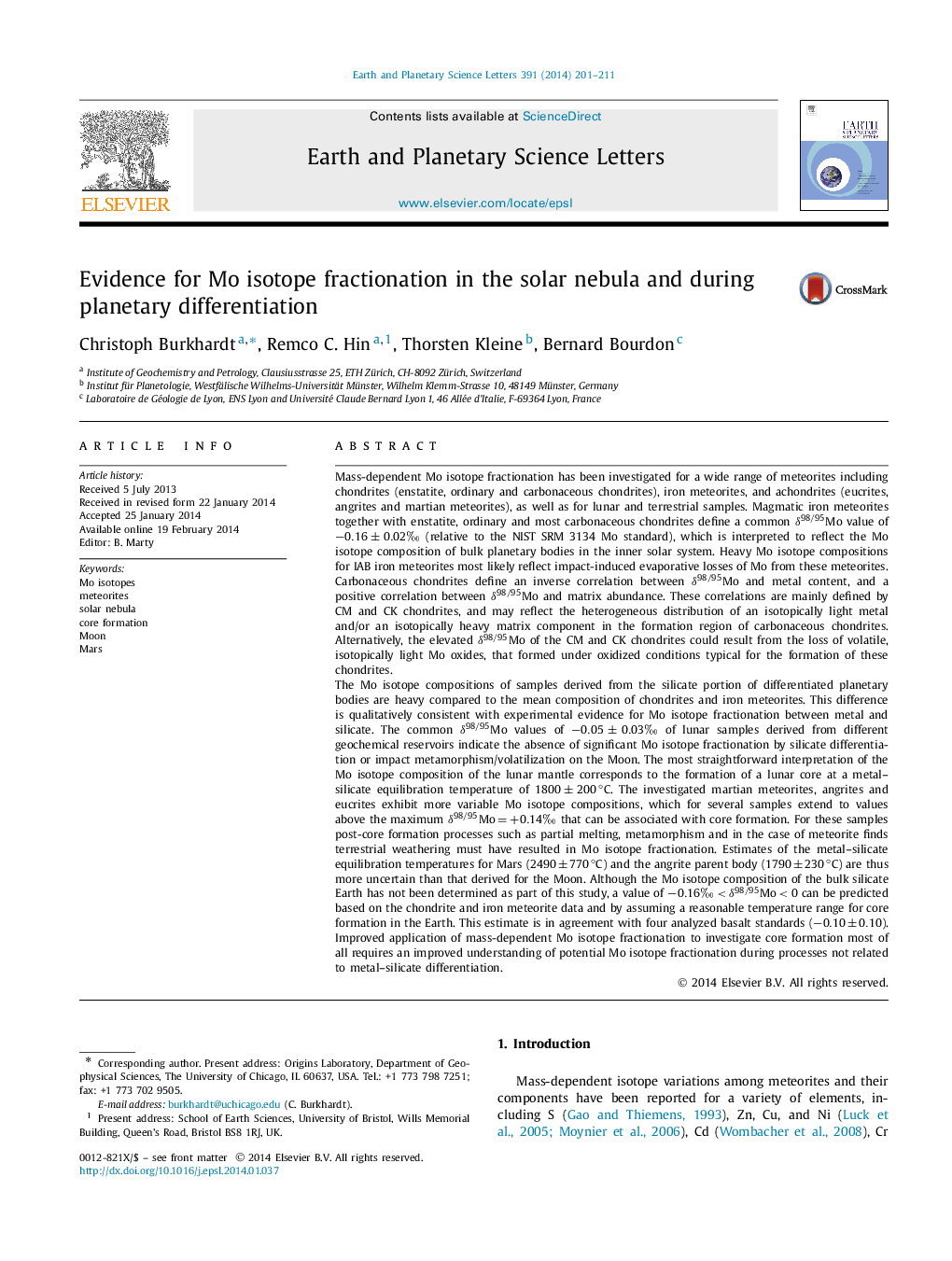| کد مقاله | کد نشریه | سال انتشار | مقاله انگلیسی | نسخه تمام متن |
|---|---|---|---|---|
| 6429442 | 1634765 | 2014 | 11 صفحه PDF | دانلود رایگان |

- Carbonaceous chondrites record nebular Mo isotope fractionation.
- Inner solar system planetary bodies are characterized by δ98/95Mo of â0.16±0.02â°.
- Isotopically heavy planetary silicates are at least partly a result of core formation.
- Mo isotopes give lunar core formation temperature of 1800±200°C.
- Composition of â0.16<δ98/95Mo<0 predicted for the BSE agrees with basalt data.
Mass-dependent Mo isotope fractionation has been investigated for a wide range of meteorites including chondrites (enstatite, ordinary and carbonaceous chondrites), iron meteorites, and achondrites (eucrites, angrites and martian meteorites), as well as for lunar and terrestrial samples. Magmatic iron meteorites together with enstatite, ordinary and most carbonaceous chondrites define a common δ98/95Mo value of â0.16±0.02â° (relative to the NIST SRM 3134 Mo standard), which is interpreted to reflect the Mo isotope composition of bulk planetary bodies in the inner solar system. Heavy Mo isotope compositions for IAB iron meteorites most likely reflect impact-induced evaporative losses of Mo from these meteorites. Carbonaceous chondrites define an inverse correlation between δ98/95Mo and metal content, and a positive correlation between δ98/95Mo and matrix abundance. These correlations are mainly defined by CM and CK chondrites, and may reflect the heterogeneous distribution of an isotopically light metal and/or an isotopically heavy matrix component in the formation region of carbonaceous chondrites. Alternatively, the elevated δ98/95Mo of the CM and CK chondrites could result from the loss of volatile, isotopically light Mo oxides, that formed under oxidized conditions typical for the formation of these chondrites.The Mo isotope compositions of samples derived from the silicate portion of differentiated planetary bodies are heavy compared to the mean composition of chondrites and iron meteorites. This difference is qualitatively consistent with experimental evidence for Mo isotope fractionation between metal and silicate. The common δ98/95Mo values of â0.05±0.03â° of lunar samples derived from different geochemical reservoirs indicate the absence of significant Mo isotope fractionation by silicate differentiation or impact metamorphism/volatilization on the Moon. The most straightforward interpretation of the Mo isotope composition of the lunar mantle corresponds to the formation of a lunar core at a metal-silicate equilibration temperature of 1800±200°C. The investigated martian meteorites, angrites and eucrites exhibit more variable Mo isotope compositions, which for several samples extend to values above the maximum δ98/95Mo=+0.14â° that can be associated with core formation. For these samples post-core formation processes such as partial melting, metamorphism and in the case of meteorite finds terrestrial weathering must have resulted in Mo isotope fractionation. Estimates of the metal-silicate equilibration temperatures for Mars (2490±770°C) and the angrite parent body (1790±230°C) are thus more uncertain than that derived for the Moon. Although the Mo isotope composition of the bulk silicate Earth has not been determined as part of this study, a value of â0.16â°<δ98/95Mo<0 can be predicted based on the chondrite and iron meteorite data and by assuming a reasonable temperature range for core formation in the Earth. This estimate is in agreement with four analyzed basalt standards (â0.10±0.10). Improved application of mass-dependent Mo isotope fractionation to investigate core formation most of all requires an improved understanding of potential Mo isotope fractionation during processes not related to metal-silicate differentiation.
Journal: Earth and Planetary Science Letters - Volume 391, 1 April 2014, Pages 201-211